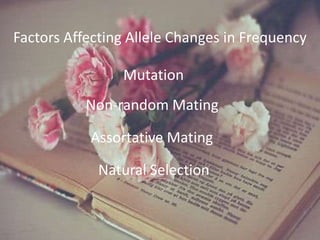
Factors Affecting Allele Changes in Frequency: Mutation
- 1. Factors Affecting Allele Changes in Frequency Mutation Non-random Mating Assortative Mating Natural Selection
- 2. MutationMutation is the permanent alteration of the nucleotide sequence of the genome of an organism, virus, or extrachromosomal DNA or other genetic elements. Mutations result from errors during DNA replication or other types of damage to DNA, which then may undergo error- prone repair (especially microhomology-mediated end joining), or cause an error during other forms of repair, or else may cause an error during replication (translesion synthesis). Mutations may also result from insertion ordeletion of segments of DNA due to mobile genetic elements. Mutations may or may not produce discernible changes in the observable characteristics (phenotype) of an organism. Mutations play a part in both normal and abnormal biological processes including: evolution, cancer, and the development of the immune system, including junctional diversity.
- 3. Mutation can result in many different types of change in sequences. Mutations in genes can either have no effect, alter the product of a gene, or prevent the gene from functioning properly or completely. Mutations can also occur in nongenic regions. One study ongenetic variations between different species of Drosophila suggests that, if a mutation changes a protein produced by a gene, the result is likely to be harmful, with an estimated 70 percent of amino acid polymorphisms that have damaging effects, and the remainder being either neutral or marginally beneficial. Due to the damaging effects that mutations can have on genes, organisms have mechanisms such as DNA repair to prevent or correct mutations by reverting the mutated sequence back to its original state.
- 4. Non-random MatingIn order to satisfy the Hardy-Weinberg equilibrium, individuals within a population must mate at random. However, in actuality, non-random mating appears to be quite common in most populations. Breeding territories, courtship display or hierarchical orders within populations are some factors that contribute to selective mating. When individuals are choosy over mates, gene frequencies are also altered. Darwin called this phenomenon sexual selection.
- 5. Assortative Mating Assortative mating is a mating pattern and a form of sexual selection in which individuals with similar phenotypes mate with one another more frequently than would be expected under a random mating pattern. Examples of similar phenotypes include, but are not limited to, body size, skin coloration/pigmentation, and age. Assortative mating, also referred to as positive assortative mating or homogamy, may increase genetic relatedness within the family. Assortative mating can be contrasted with disassortative mating (also known as negative assortative mating or heterogamy) in which individuals with dissimilar genotypes and/or phenotypes mate with one another more frequently than would be expected under random mating.
- 6. Disassortative mating reduces the genetic similarities within the family. Positive assortative mating occurs more frequently than negative assortative mating. In both cases, due to the nonrandom mating pattern, there is a deviation from the Hardy– Weinberg principle (which states that genotype frequencies in a population will remain constant from generation to generation in the absence of other evolutionary influences).
- 7. Natural selection is the differential survival and reproduction of individuals due to differences in phenotype. It is a key mechanism of evolution, the change in heritable traits of a population over time. Charles Darwin popularised the term "natural selection“ he compared it with artificial selection (selective breeding). Natural Selection
- 8. Variation exists within all populations of organisms. This occurs partly because random mutations arise in the genome of an individual organism, and offspring can inherit such mutations. Throughout the lives of the individuals, their genomes interact with their environments to cause variations in traits. (The environment of a genome includes the molecular biology in the cell, other cells, other individuals, populations, species, as well as the abiotic environment.) Individuals with certain variants of the trait may survive and reproduce more than individuals with other, less successful, variants. Therefore, the population evolves. Factors that affect reproductive success are also important, an issue that Darwin developed in his ideas on sexual selection (now often included in natural selection) and on fecundity selection, for example.
- 9. Natural selection acts on the phenotype, or the observable characteristics of an organism, but the genetic (heritable) basis of any phenotype that gives a reproductive advantage may become more common in a population (see allele frequency). Over time, this process can result in populations that specialise for particular ecological niches (microevolution) and may eventually result in theemergence of new species (macroevolution). In other words, natural selection is an important process (though not the only process) by which evolution takes place within a population of organisms. Natural selection can be contrasted with artificial selection, in whichhumans intentionally choose specific traits (although they may not always get what they want). In natural selection there is no intentional choice. In other words, artificial selection is teleological and natural selection is not teleological, though biologists often use teleological language to describe it.
- 10. THANK YOU